Introduction
The realm of managed data center services is rapidly evolving, driven by the increasing complexity of IT infrastructure and the growing demand for operational efficiency. Organizations are now presented with a diverse array of service offerings, each designed to meet specific operational needs while ensuring data security, scalability, and reliability.
From colocation and managed hosting to cloud services and disaster recovery, understanding these options is paramount for businesses aiming to leverage technology strategically. As companies navigate this intricate landscape, the selection of the right managed data center provider becomes a critical decision, influenced by factors such as performance, security, and support.
This article delves into the various types of managed data center services, key considerations for provider selection, comparative analyses of leading providers, and emerging trends that are shaping the future of this vital industry. By equipping themselves with this knowledge, organizations can make informed choices that align with their operational goals and technological advancements.
Understanding Managed Data Center Services: Types and Offerings
Managed facility solutions consist of a range of offerings aimed at improving IT infrastructure and maximizing operational efficiency for companies. The main categories of offerings include:
-
Colocation Solutions: These solutions allow organizations to lease space within a facility to accommodate their servers and networking equipment. Businesses gain access to enhanced security, efficient cooling systems, and robust power management, all of which are critical for maintaining operational integrity. Significantly, as rental prices in Santiago rose by 15% while Bogotá saw an 8% drop, organizations are increasingly seeking economical solutions in management of information storage.
-
Managed Hosting: This offering involves the provision of dedicated servers that are fully managed by the provider. By outsourcing the management of hardware to experts, businesses can focus on their core operations while ensuring that their infrastructure is consistently monitored and maintained. Cisco's recent declaration about their investment in a dedicated information center in India for WebEx highlights the increasing significance of managed solutions in today’s market environment.
-
Cloud Solutions: Managed cloud solutions offer businesses scalable resources and flexibility, enabling them to utilize the advantages of cloud computing without the intricacies linked to overseeing the foundational infrastructure. This adaptability is crucial as businesses scale and evolve.
-
Disaster Recovery and Backup Solutions: These crucial offerings protect information security and guarantee business continuity through regular backups and efficient recovery methods. They are vital for minimizing downtime during emergencies, thus preserving operational capabilities.
-
Network Management: This offering includes the monitoring and administration of network performance, ensuring optimal connectivity and improved security for information transmission. Efficient network administration is crucial for sustaining smooth operations across all digital platforms.
By identifying and comprehending these varied solutions, companies can strategically align their operational goals with the suitable managed computing facilities. This informed approach facilitates a more effective comparison of suppliers, ensuring that organizations choose solutions that best fit their technological and operational requirements. Moreover, as demonstrated by the power generators market expansion, which is expected to increase from $1776.61 billion in 2022 to $1913.39 billion in 2023, comparable growth patterns can be expected in the managed information services market, emphasizing the significance of strategic decision-making in this changing industry.
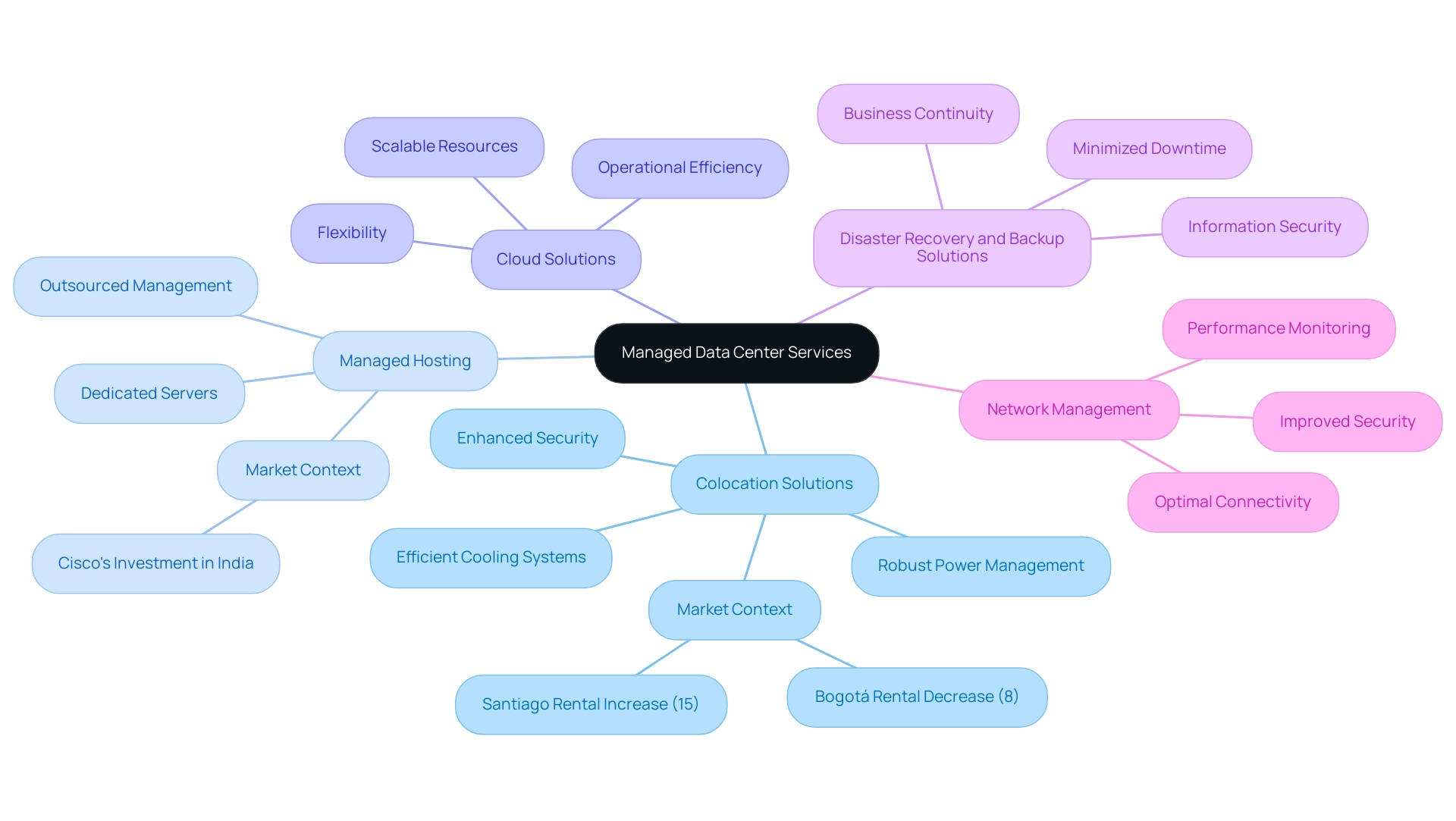
Choosing the Right Managed Data Center Provider: Key Considerations
When choosing a managed data center service, organizations must evaluate several essential factors to ensure optimal performance and reliability:
-
Performance and Reliability: It is crucial to evaluate the service's uptime guarantees and performance metrics. With the market for cloud IT infrastructure expected to hit USD $133.7 billion by 2026, as highlighted by research expert Petroc Taylor, prioritizing a supplier that can ensure operational continuity is crucial for reducing interruptions to business activities.
-
Security Measures: In an era where data breaches are increasingly prevalent, understanding the organization's security protocols—spanning physical security to advanced cybersecurity measures—is essential for safeguarding sensitive information. Recent trends indicate that the demand for robust security measures is not only a priority but a necessity for any reputable provider.
-
Scalability: The capability to modify offerings in alignment with business growth or fluctuating needs is crucial for maintaining operational efficiency. A service that offers flexible scaling options can help organizations adapt swiftly to changing market conditions. Notably, with USD $70 billion waiting to be invested in the Asia Pacific region as markets are poised for recovery in 2025, scalability becomes even more significant for businesses looking to capitalize on emerging opportunities.
-
Support and Management: Evaluating the level of support provided, including technical assistance and account management, is vital. Effective support ensures that businesses receive timely resolutions to issues, thereby enhancing operational efficiency and minimizing downtime.
-
Cost Structure: Understanding the pricing model, including any potential hidden fees for additional services, is key to effective budget management. Transparency in pricing allows organizations to plan their expenditures without unexpected financial burdens.
-
Compliance and Certifications: Ensuring that the supplier adheres to industry standards and compliance requirements is critical, especially for businesses in regulated sectors. This adherence not only mitigates risks but also enhances the credibility of the supplier.
-
Impact of AI on Staffing: The incorporation of AI technologies is progressively affecting information hub operations. A recent case study revealed that 73% of operators expect AI to reduce staffing levels in facilities, suggesting a shift towards automation and efficiency that organizations should consider when selecting a managed provider.
By meticulously weighing these considerations, businesses can choose managed data center service companies that not only meet their current operational needs but also strategically support their future growth and technological advancements. Notably, the B.I. and Analysis segment of the information hub market is anticipated to achieve the highest CAGR of 18.5% from 2023 to 2030, further highlighting the significance of making a well-informed decision in this swiftly changing environment.
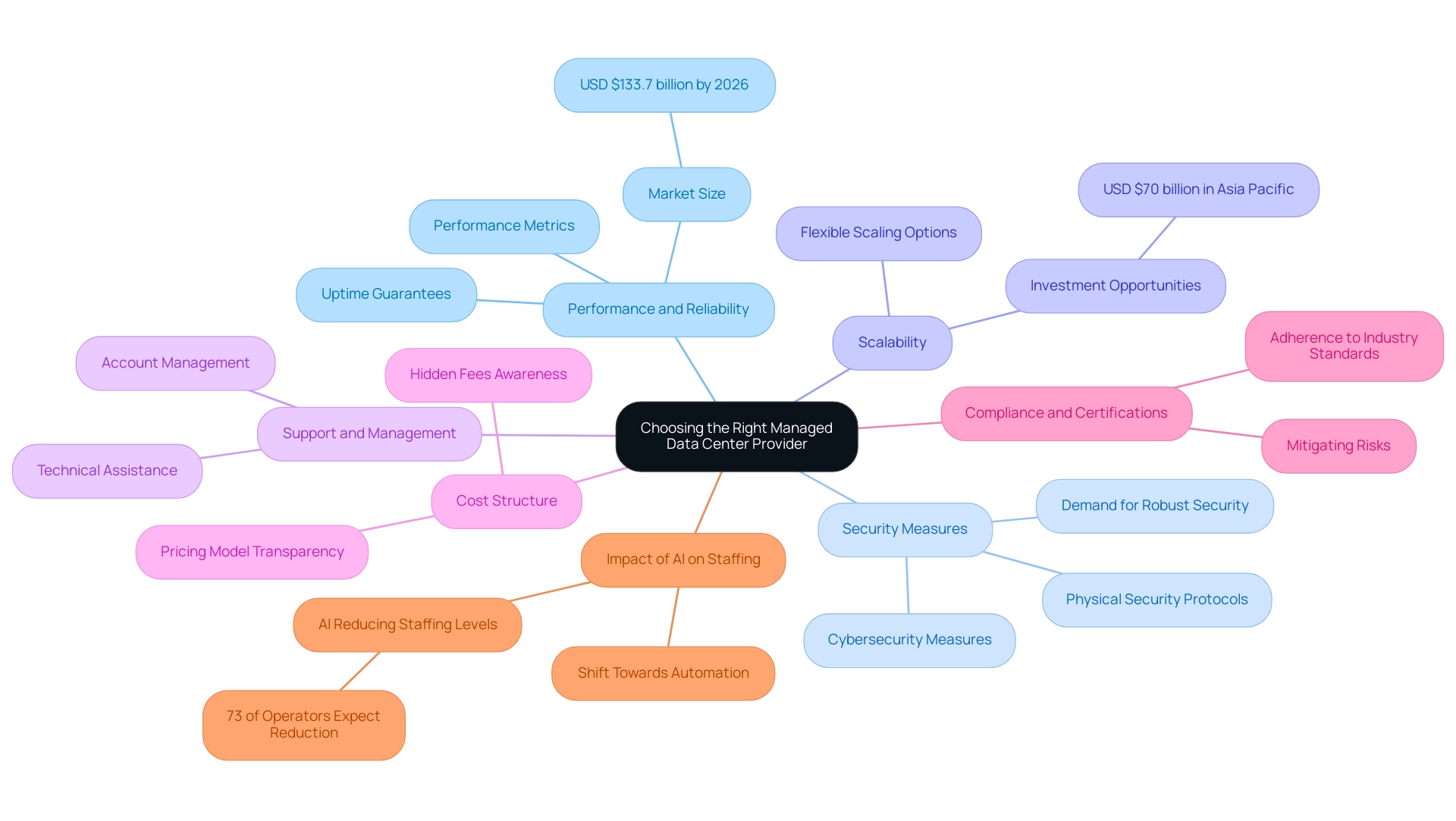
Comparative Analysis of Leading Managed Data Center Providers
This analysis focuses on three prominent managed data center service companies—Company A, Company B, and Company C—each offering unique advantages that cater to varying business needs.
- Company A: Renowned for its comprehensive cloud solutions, Company A stands out with exceptional scalability and a user-friendly interface. While its offerings are robust, the pricing structure tends to be higher, potentially limiting accessibility for smaller enterprises.
Significantly, São Paulo’s availability rose to 62.1 MW from 52.3 MW in Q1 2024, reflecting the increasing demand for such offerings in the region.
- Company B: This provider is distinguished by its commitment to security, featuring advanced cybersecurity protocols and adherence to rigorous compliance standards. Although its pricing is competitive, the adaptability of its colocation offerings falls short in comparison with its peers, which might deter some clients seeking flexible solutions.
The cybersecurity landscape is a crucial consideration, as 60% of respondents identified it as a top challenge, prompting partnerships with MSPs.
- Company C: Emphasizing personalized customer support, Company C excels in tailoring its management services to meet specific client requirements. However, variability in performance metrics can be concerning for organizations that prioritize consistent uptime, raising questions about reliability.
The expansion of hyperscale projects in Rio de Janeiro further contextualizes the competitive environment these companies operate within. By meticulously evaluating these attributes, organizations can better navigate the advantages and limitations of each supplier. Such insights are crucial for CTOs aiming to align their choice with operational priorities, ultimately leading to a more informed decision-making process.
Moreover, customer satisfaction ratings for managed data center service companies in 2024 indicate differing levels of service effectiveness, further informing this comparative analysis. Recent evaluations emphasize the strengths of each supplier, showcasing how their unique offerings may align with specific business objectives. As Aixa Velez highlighted in the Cushman & Wakefield reports, comprehending these dynamics is crucial for making strategic choices in today's information hub environment.
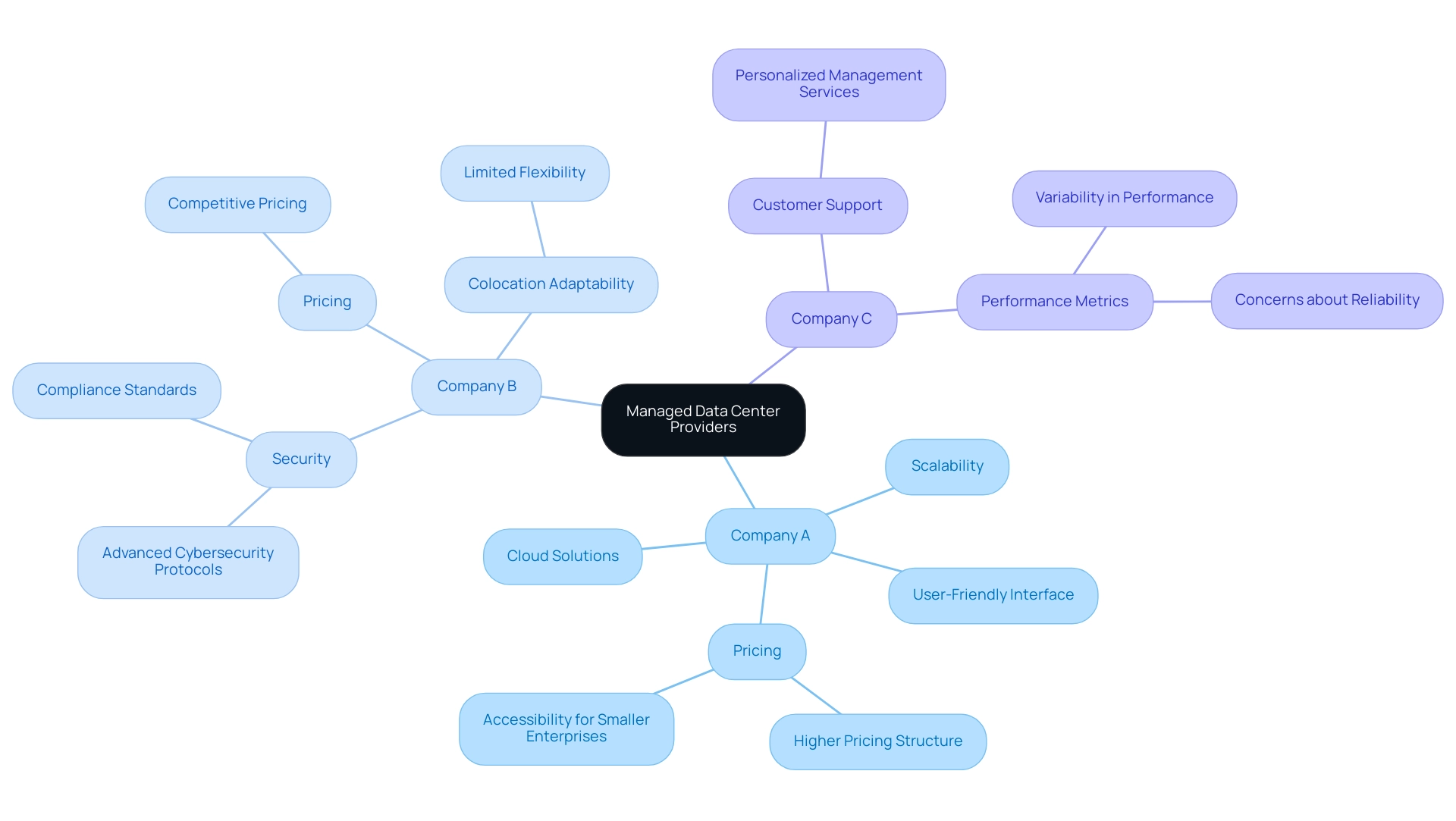
Evaluating Customer Support and Service Levels
When assessing managed facilities providers, it is essential to examine the quality of customer assistance and support levels. Key factors to consider include:
-
Availability of Support: The operational hours of customer support are crucial, particularly for businesses that may require assistance outside of traditional working hours. Providers offering 24/7 support can significantly enhance operational reliability, especially in markets like Finland, where data centers benefit from over 8,000 hours of free cooling per year, allowing for more efficient operations. As one client noted, "Using STS Consulting Group helped me save weeks of work. Their delightful standard of quality and support is consistent and unique. I can't recommend STS Consulting Group enough."
-
Response Times: Analyzing the response times to support requests serves as an indicator of the provider's efficiency and commitment to customer satisfaction. Recent statistics indicate that consumers who report a good customer support experience are 38% more likely to recommend that company than those who have had a negative experience (Qualtrics). This statistic underscores the critical role that prompt and effective support plays in customer retention and satisfaction. A client shared, "I was really impressed with the way STS Consulting Group handled everything. From the first conversation to everything in between, they were very helpful and knowledgeable."
-
Expertise of Support Staff: The qualifications and experience of the support team are vital to the quality of assistance provided. A knowledgeable team can effectively troubleshoot and resolve technical issues, minimizing downtime and enhancing reliability. In regions like Queretaro, Mexico, where supply constraints exist with less than 1.2 MW available for lease, having a competent support team becomes even more essential to navigate potential challenges. As another client mentioned, "STS Consulting Group was the missing piece to my puzzle. From start to finish, they solved every problem and helped us achieve our goals in the most professional way possible."
-
Customer Feedback: Assessing testimonials and case studies offers valuable insights into the experiences of other clients. These testimonials emphasize how customer satisfaction is closely tied to effective assistance and can greatly impact overall market competitiveness and client loyalty.
By meticulously evaluating these factors, businesses can ensure they choose a service that prioritizes customer satisfaction and is well-equipped to address their IT needs. This due diligence not only enhances operational efficiency but also fosters a solid partnership that can adapt to evolving technological demands.
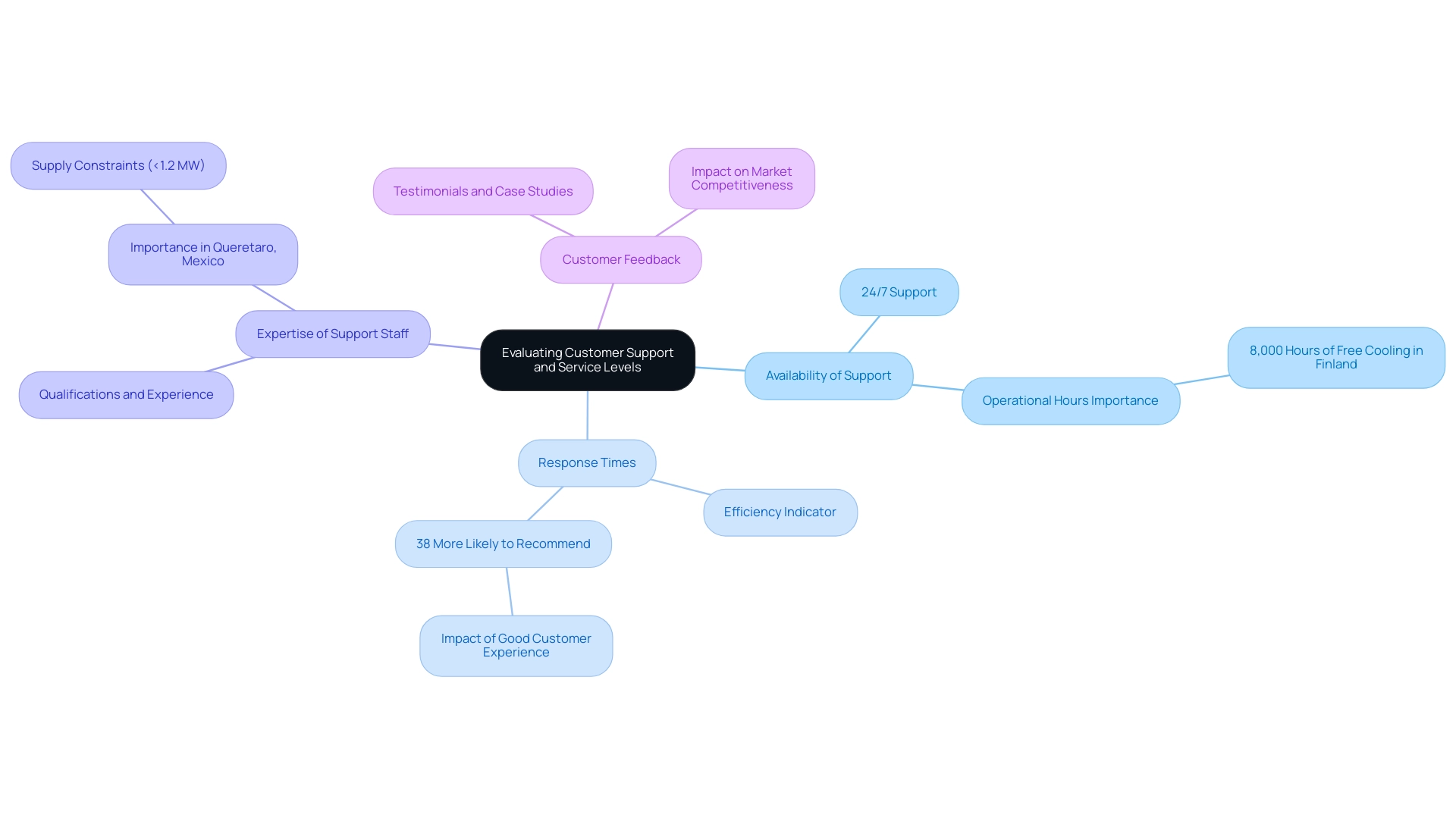
Future Trends in Managed Data Center Services
The managed infrastructure landscape is experiencing a significant change, influenced by swift technological progress and evolving organizational priorities. Key trends that are poised to influence this evolution include:
-
Increased Adoption of Hybrid Solutions: A significant number of businesses are gravitating towards hybrid models that seamlessly integrate on-premises infrastructure with cloud solutions.
This approach not only enhances flexibility but also enables scalability without incurring substantial capital expenses, which is a crucial factor for organizations moving to colocation. Notably, 80% of security and cybersecurity applications are currently under consideration for migration from cloud to colocation, marking an increase from 70% in the previous year. -
Focus on Automation and AI: The integration of automation and artificial intelligence is becoming a cornerstone for providers aiming to boost operational efficiency and reduce costs.
These technologies enhance service delivery and allow information hubs to adjust rapidly to shifting demands. As of 2024, statistics indicate a marked increase in automation within information facilities, underscoring its critical role in operational strategies. -
Emphasis on Sustainability: In light of growing environmental concerns, organizations are prioritizing sustainability in their operations.
Data facility providers are responding by adopting greener practices, which include the implementation of energy-efficient technologies and the utilization of renewable energy sources. This trend is not just about compliance; it reflects a commitment to responsible stewardship of resources. -
Enhanced Security Protocols: With the escalating frequency of cyber threats, there is a heightened focus on security within managed information centers.
Providers are making substantial investments in advanced security measures, such as encryption, identity management, and threat detection, to safeguard client information and ensure compliance with increasingly stringent regulations. In 2024, significant advancements in security and compliance for hybrid cloud environments are expected, addressing the complexities of these systems and further enhancing privacy and protection. The continuous enhancements in connectivity to significant cloud providers from 2022 to 2024 also play a crucial part in this evolution, making hybrid solutions more feasible and appealing.
By keeping up with these trends, organizations can make informed strategic decisions that align with the upcoming advancements in managed data center service companies. As nearly 100% of American companies currently utilize cloud services, it is evident that the trajectory towards hybrid solutions is not just a trend, but a defining feature of the future landscape.
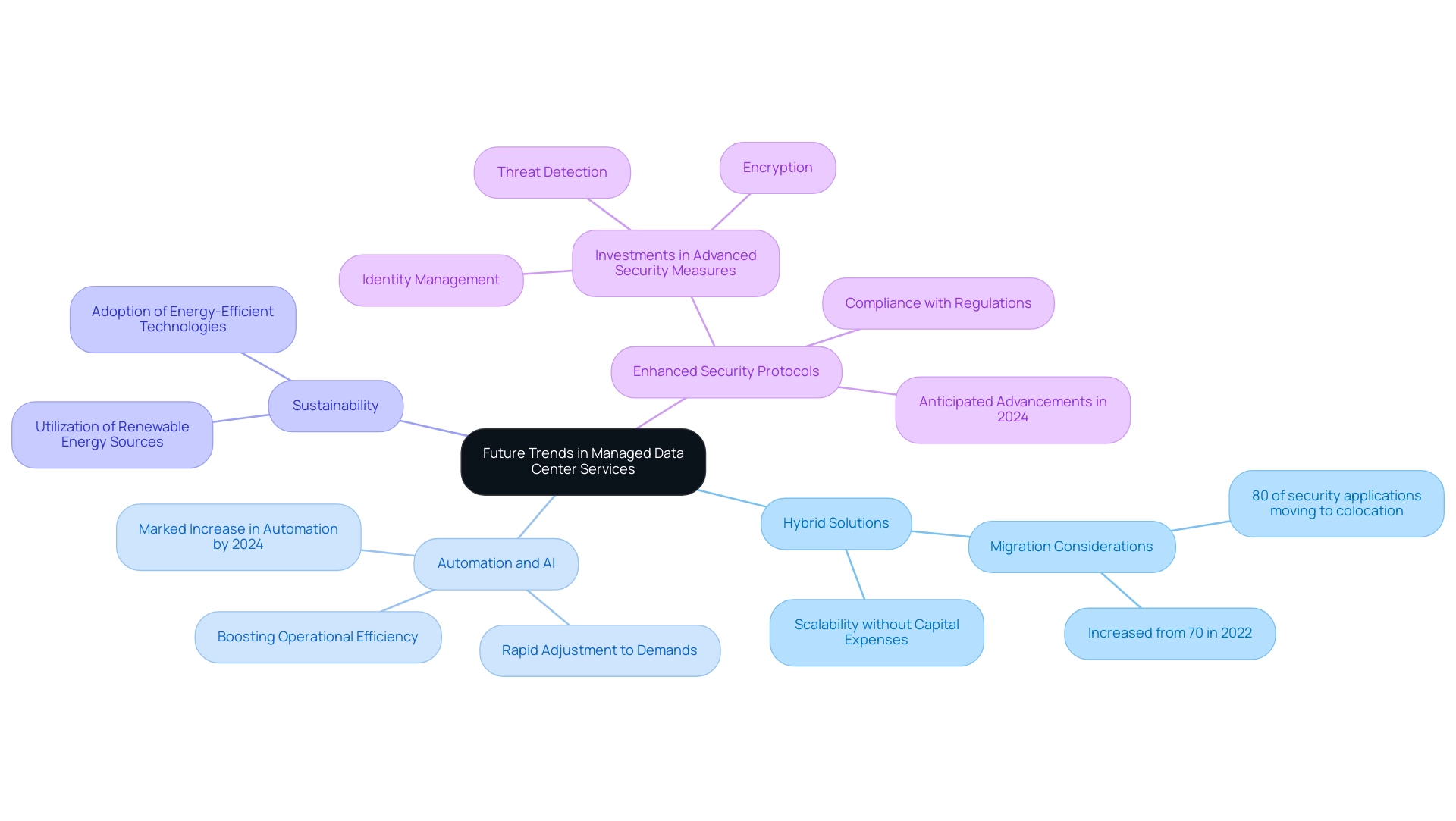
Conclusion
Managed data center services are essential for organizations aiming to optimize their IT infrastructure in an increasingly complex digital landscape. By exploring the various types of services available—ranging from colocation to cloud solutions—businesses can strategically align their operational goals with the appropriate offerings. Understanding the nuances of each service type, including their benefits and limitations, enables informed decision-making that is crucial for maintaining competitive advantage.
Selecting the right managed data center provider involves careful consideration of multiple factors, including:
- Performance
- Security
- Scalability
- Support
Each of these elements plays a vital role in ensuring that the chosen provider can meet both current and future operational needs. As the market continues to evolve, organizations must remain vigilant in evaluating providers based on their ability to deliver reliable services that adapt to changing demands.
The comparative analysis of leading providers highlights the diverse advantages each can offer while emphasizing the importance of customer support and service levels. By prioritizing these aspects, businesses can foster partnerships that enhance operational efficiency and responsiveness to technological shifts. Furthermore, recognizing emerging trends such as:
- Hybrid solutions
- Automation
- Sustainability
will empower organizations to make strategic choices that position them favorably in the future landscape of managed data center services.
In conclusion, the journey toward selecting a managed data center provider is multifaceted and requires a thorough understanding of both the offerings and the market dynamics. By leveraging the insights provided throughout this discussion, organizations can navigate the complexities of managed data center services more effectively, ensuring they are well-equipped to meet their operational challenges head-on.




